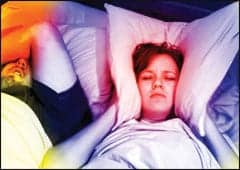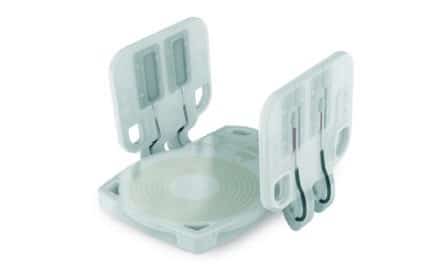Numerous studies have been published looking at OSA from all angles, but there is a part of this problem that hasn’t had much investigation: namely, the bed partner. Despite their potential role in compliance and endurance of negative health consequences related to the patient’s OSA, the bed partner remains overlooked.
RATTLING THE WINDOWS? SNORING IS A BIG PROBLEM
 |
Most of the patients who have been diagnosed with OSA are male. The incidence of OSA for males versus females is about 2:1 (twice as many males have the problem as females). Thus, most of the research looking at the impact of OSA on bed partners involves a female population. Many articles acknowledge that the patient arriving at the doorstep of a physician’s office or sleep disorders center is there at the prompting of the bed partner whose sleep has been disrupted by loud snoring, restless sleep, and fear related to witnessing the patient’s apnea. Snoring is not always related to OSA but often accompanies the problem or is a precursor to the development of OSA, and snoring appears to be the most frequently mentioned complaint of the bed partner.
In a study published in 2000, Ulfberg et al looked at the impact of snoring on Swedish women’s health and found many problems.1 The researchers compared responses from a control group of women to a study group of women. The control group contained 728 women in the general population who responded to the questionnaire out of 1,000 who were sent the questionnaire in a random sample. All of these women lived with male partners. The study group contained 351 women (who responded to the same questionnaire) out of a sample of 500 whose spouses all had heavy snoring and had undergone polysomnography. In addition to heavy snoring, 32% of the husbands in the study group were diagnosed with OSA. (The control group reported heavy snoring in 28% of the spouses.)
The study found that 78 (or 38%) of the women in the study group slept in another room compared to 83 women (or 11%) in the control group. The women in the study group had about twice as many problems with initiating and maintaining their sleep, excessive daytime sleepiness, and fatigue. Insomnia occurred at three times the rate of the control group. The study group also had more instances of morning headache.
It was interesting to note that sleeping in another room did not reduce the health complaints from the study group. This strategy has often been used by women to try to regain a good night’s sleep, according to these findings, but apparently it doesn’t have a positive or significant impact.
The odds ratios in the study were adjusted for various factors including age, the women’s own incidence of snoring, body mass index, the number of children living at home who were under 18 years old, whether the women were employed, and whether they took pharmacologic sleeping aids.
WHAT HAPPENS AFTER TREATMENT?
Two articles, both published in Chest in 2003, examined the change in quality of life of bed partners of patients who had OSA and were receiving CPAP therapy. In the first article, Doherty et al out of Dublin, Ireland, acknowledged that CPAP machines are “cumbersome” and generate some noise, which may have a negative impact on the bed partner.2
Their research looked at the impact of CPAP therapy on both the patient and the bed partner by using a prospective approach and standardized questionnaires to gauge the change before and after initiating CPAP. The standardized questionnaires were the Short-Form 36 (SF-36), the Hospital Anxiety and Depression Scale (HADS), and the Epworth Sleepiness Scale (ESS). The SF-36 asks 36 questions to assess the subject’s self-perception of performance in eight dimensions of daily life. The HADS scores the subject in seven items related to anxiety and seven items related to depression. The ESS is a validated subjective assessment of daytime sleepiness.
The study included 55 couples (each of whom included a patient recently diagnosed with OSAS). Ten of the 55 couples did not regularly share a bed. Prior to starting CPAP, the couples responded to the set of three questionnaires; after approximately 6 to 8 weeks of therapy, the couples responded again to the same questionnaires.
Focusing on the results for the bed partners, the study found that anxiety levels after the CPAP therapy were significantly improved. Significant improvement was also seen in the domains of role limitation due to physical problems, role limitation due to emotional problems, social functioning, mental health, and energy and vitality for the bed partner.
The 10 couples who slept apart had no differences from the other 45 couples in terms of age, body mass index (BMI), apnea-hypopnea index (AHI), and pretreatment scores on ESS or quality-of-life indexes, but the 10 couples showed lower scores on the HADS and SF-36. After CPAP therapy, the scores for both the partner “sleeping-with” and the partner “sleeping-without” showed “broadly similar improvements in quality of life measurements.” The authors speculated that loud snoring and restless sleep result in sleep fragmentation and a subsequent decrease in quality of life. Also, insomnia could be the result of “worry caused by witnessing recurring apneas.” Finally, they also mentioned that the partner’s sleep deprivation could cause more problems with depressed mood, poor memory, and increased irritability, which could lead to a declining relationship with the spouse.
In the conclusion, the researchers acknowledged that their data adds to the growing body of evidence that CPAP therapy improves the quality of life and health status of the bed partner (as well as the patient) and that together, the physician and the bed partner could have a greater impact on CPAP compliance as a boon to both the patient and the partner.2
The second article published in 2003 came from two researchers (Parish and Lyng) associated with the Division of Pulmonary Medicine, Mayo Clinic, Scottsdale, Ariz. This study also looked at the impact of CPAP therapy on couples by using a prospective approach and standardized questionnaires to gauge the change before and after initiating CPAP. Two of the same questionnaires were used (ESS and SF-36), but the third questionnaire was different. The study included the Calgary Sleep Apnea Quality of Life Index (SAQLI), which assesses quality of life specifically for OSA. SAQLI scores in five domains: daily functioning, social interaction, emotional functioning, symptoms, and, after therapy is initiated, treatment-related symptoms3—54 couples completed the entire study.
Assessment of CPAP compliance in the group revealed that the devices were used with a mean of 6.1 hours nightly. The bed partner’s post-treatment scores showed significant improvement in the SF-36 domains of role-physical, vitality, social functioning, and mental health. There was no significant difference in the domains of general health, bodily pain, physical functioning, and role-emotional. The SAQLI scores for bed partners showed significant change in the domains of daily functioning, social interaction, and emotional functioning. The symptoms domain showed improvement but was not significant statistically, and the last domain, treatment-related symptoms, did not apply since the bed partners did not receive the CPAP therapy. The sleepiness score (ESS) decreased from 7.4 ± 6.1 to 5.8 ± 4.7 (P = 0.02), which was not statistically significant but a downward trend.3
In an editorial related to the Parish-Lyng study, Ashtyani and Hutter point out that this study was notable in that it did not follow the trend of previous studies of examining the quality of sleep in bed partners, but looked at daytime functioning and general health and showed that both areas improved after therapy was started for the patient.4
NEED FOR MORE RESEARCH
Despite the findings of these studies, there are unanswered questions. How can OSA damage relationships? What about the impact of CPAP therapy on sex? Depression, anxiety, and decreased quality of life appear to be part of the impact of OSA on both the patient and the bed partner, and these factors all seem to improve after CPAP therapy, but the full impact is not clear. What role do the bed partners play in getting the snorers to the sleep lab? Apparently, they have a very significant role, but this has not been established definitively. What role does the bed partner play in compliance? Again, this appears to be a part of the influence for using CPAP, but how much of a part? Are there differences in compliance/sleep problems when considering married versus nonmarried people? The studies mentioned in this article point to answers for some of the issues bed partners face when having to deal with spouses and snoring, OSA, and CPAP, but there are areas related to this topic that are still untouched and the wealth of research needed to draw evidence-based conclusions appears to be lacking.
Bill Pruitt, MBA, RRT, CPFT, AE-C, is the director of clinical education and a senior instructor in the Cardiorespiratory Care Department, College of Allied Health, University of South Alabama, Mobile. He is a well-known teacher, writer, and lecturer, and likes to “keep in touch with the real world” by working as a PRN therapist at the Mobile Infirmary Medical Center and the Springhill Medical Center. He also volunteers in the Asthma and COPD Pulmonary Clinic at Victory Health Partners, a clinic for the uninsured that provides pulmonary testing, education, and treatment of lung disorders such as asthma, emphysema, and smoking disorders, plus the recently added service of evaluating sleep and the use of CPAP therapy. The author can be reached at [email protected].
REFERENCES
- Ulfberg J, Carter N, Talback M, Edling C. Adverse health effects among women living with heavy snorers. Health Care Women Int. 2000;2:81–90.
- Doherty LS, Kiely JL, Lawless G, McNicholas WT. Impact of nasal continuous positive airway pressure therapy on the quality of life of bed partners of patients with obstructive sleep apnea syndrome. Chest. 2003;124(6):2209-2214.
- Parish JM, Lyng PJ. Quality of life in bed partners of patients with obstructive sleep apnea or hypopnea after treatment with continuous positive airway pressure. Chest. 2003;124(3):942-947.
- Ashtyani H, Hutter DA. Collateral damage: the effects of obstructive sleep apnea on bed partners. Chest. 2003;124(3):780-1.




